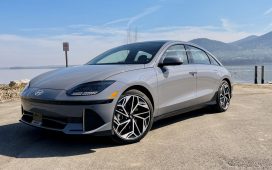Ford’s third-ever all-electric vehicle is a Europe-only crossover SUV with one of the automaker’s most popular nameplates. The Explorer EV will also be the first in a wave of new plug-in vehicles for the automaker’s overseas lineup, as it works toward an electric-only portfolio in Europe by 2030.
The Explorer EV may carry a familiar nameplate, but it will be built on top of an unfamiliar platform — for Ford, at least. The automaker is using Volkswagen’s flexible MEB architecture for the new EV, which will be built at Ford’s factory in Cologne, Germany. The Explorer EV will be the first of two vehicles from Ford that will utilize VW’s electric platform as part of an agreement that was established when the two companies formed a global alliance in 2019.
The Explorer EV may carry a familiar nameplate, but it will be built on top of an unfamiliar platform
Ford said it won’t release the vehicle’s range until it’s closer to production, but it did reveal details about its pricing. The Explorer EV will be available in two trims — Explorer and Explorer Premium — with starting pricing “less than €45,000” (or about $48,250). Reservations are open now through Ford’s European website.
The most noticeable feature in the new electric Explorer is a moveable 15-inch center touchscreen that the company says should be better for dealing with outside glare. The screen, which can move up and down, also conceals a built-in lockable storage space for valuables. Here’s a GIF of the movable screen:
The Ford Explorer EV is significant because it’s only the third all-electric vehicle to be announced by the iconic American automaker. (I’m not counting the Ford Focus Electric and some of the company’s compliance vehicles, for what it’s worth.) The company’s current EV lineup includes the Mustang Mach-E and F-150 Lightning, which have propelled Ford to its status as the No. 2 seller of electric vehicles in the US. Still, the company has a ways to go if it wants to catch up to the No. 1 seller, Tesla, and the European market will play a big role in that.
It also needs to get a better handle on a number of quality issues that have plagued its EV push. Ford recently recalled over a dozen F-150 Lightnings over concerns about a battery problem. In 2022, Ford issued more recalls in America than any other automaker.
Ford’s plans for Europe are ambitious. The company is spending $1 billion to convert its German factory into an EV-only assembly line, with the goal of producing 1.2 million vehicles over six years.
Those products include three new passenger vehicles, including a sport crossover with a range of 500km (311 miles) and an electric version of the company’s Ford Puma, a compact crossover that will go into production at the company’s plant in Craiova, Romania, in 2024.
Ford’s plans for Europe are ambitious
Ford will also put four commercial EVs into production, including electric versions of its Transit Courier and Tourneo Courier multipurpose vans. (The company’s first commercial EV, the E-Transit van, is already available to customers in Europe.)
An electric Explorer for the US market is still in the works. The company has said it plans to launch an Explorer EV for North America, which will be built at Ford’s factory in Oakville, Ontario, by the end of 2024 (after a previous plan to produce it alongside the Mustang Mach-E in Cuautitlan, Mexico, was scrapped). The Oakville facility, where the gas-powered Ford Edge and Lincoln Nautilus are built, is in the process of being converted to an EV-only plant.
Ford is also developing a new electric truck for North America that will likely go on sale in 2025. Details are scarce, but the new EV truck will feature an “all-new” nameplate, not a redesigned F-150 Lightning, and will help bolster Ford as a leader in electric trucks.











